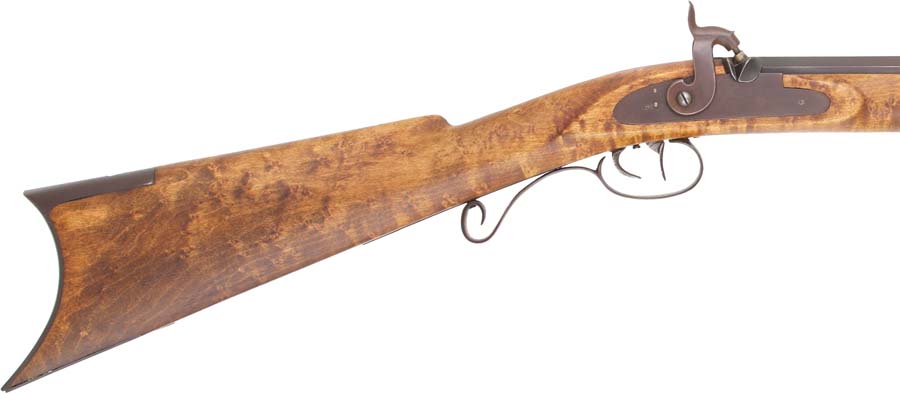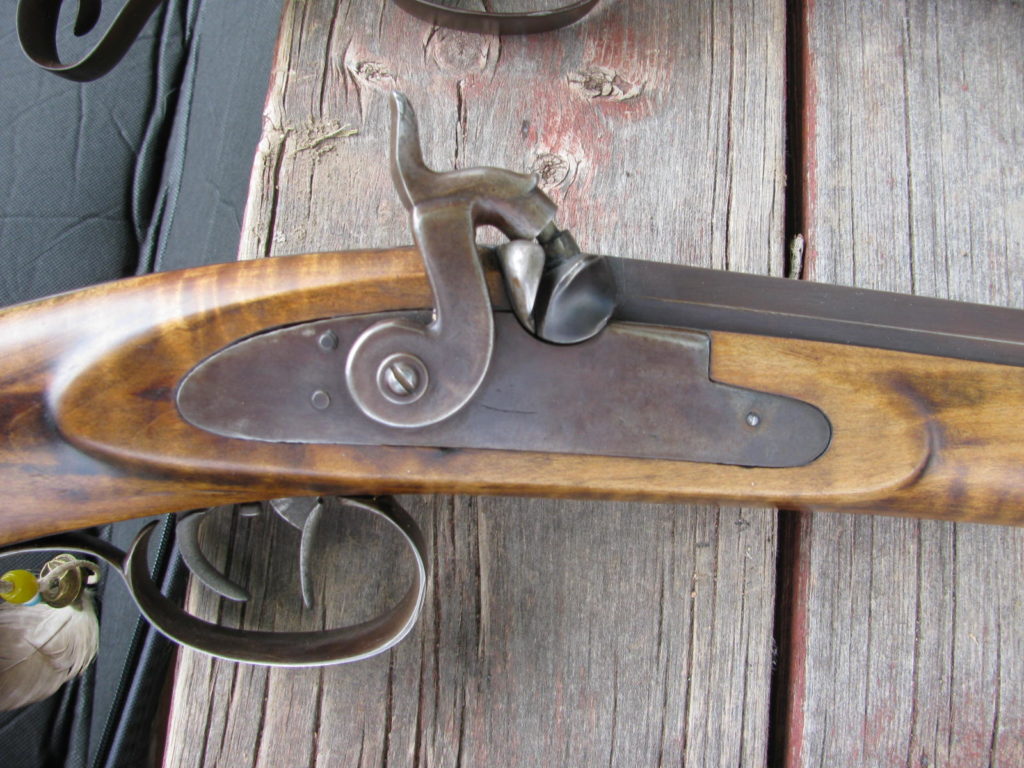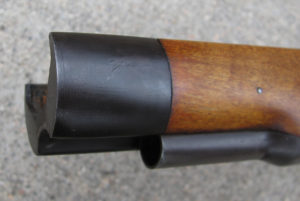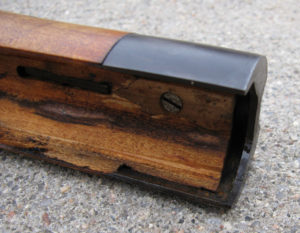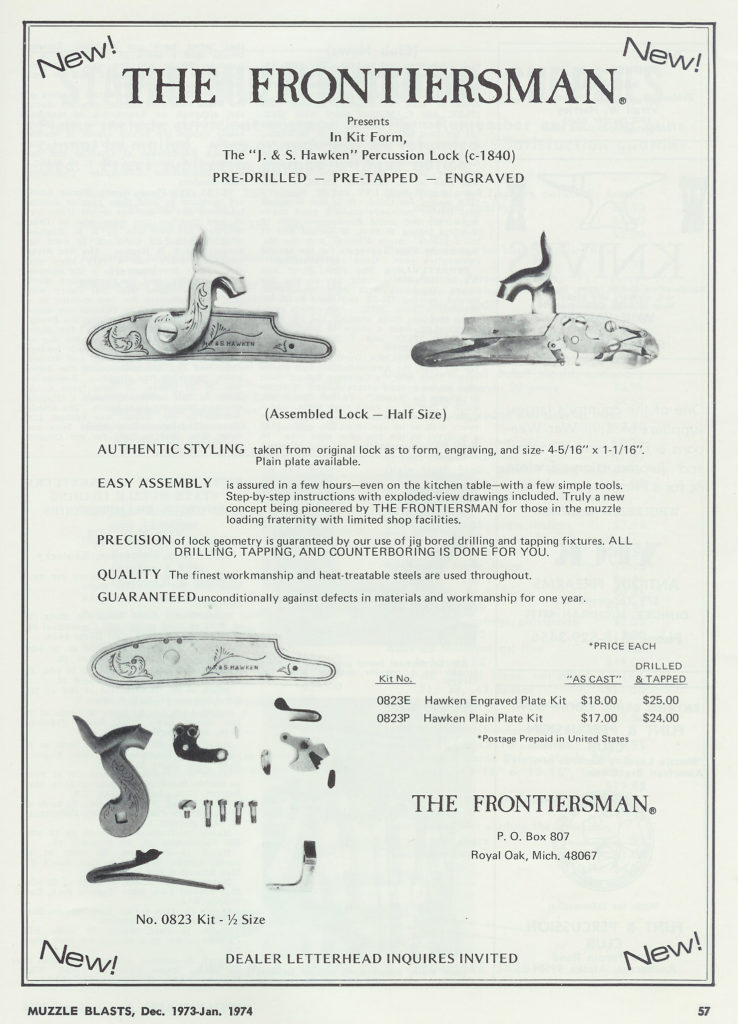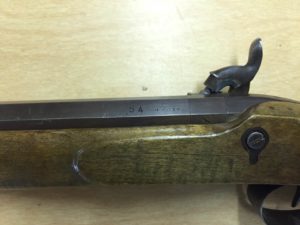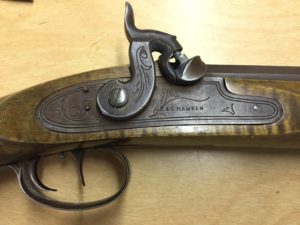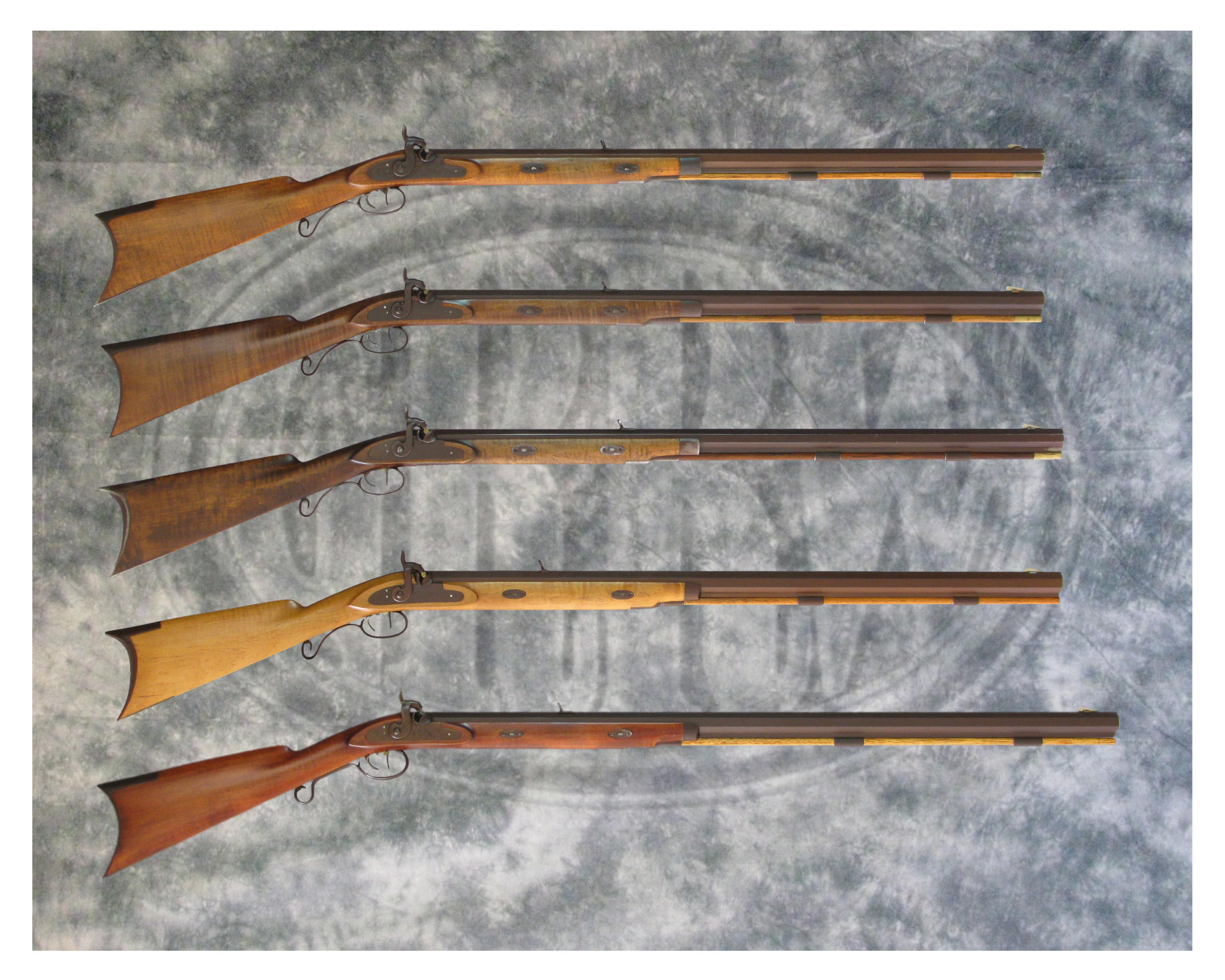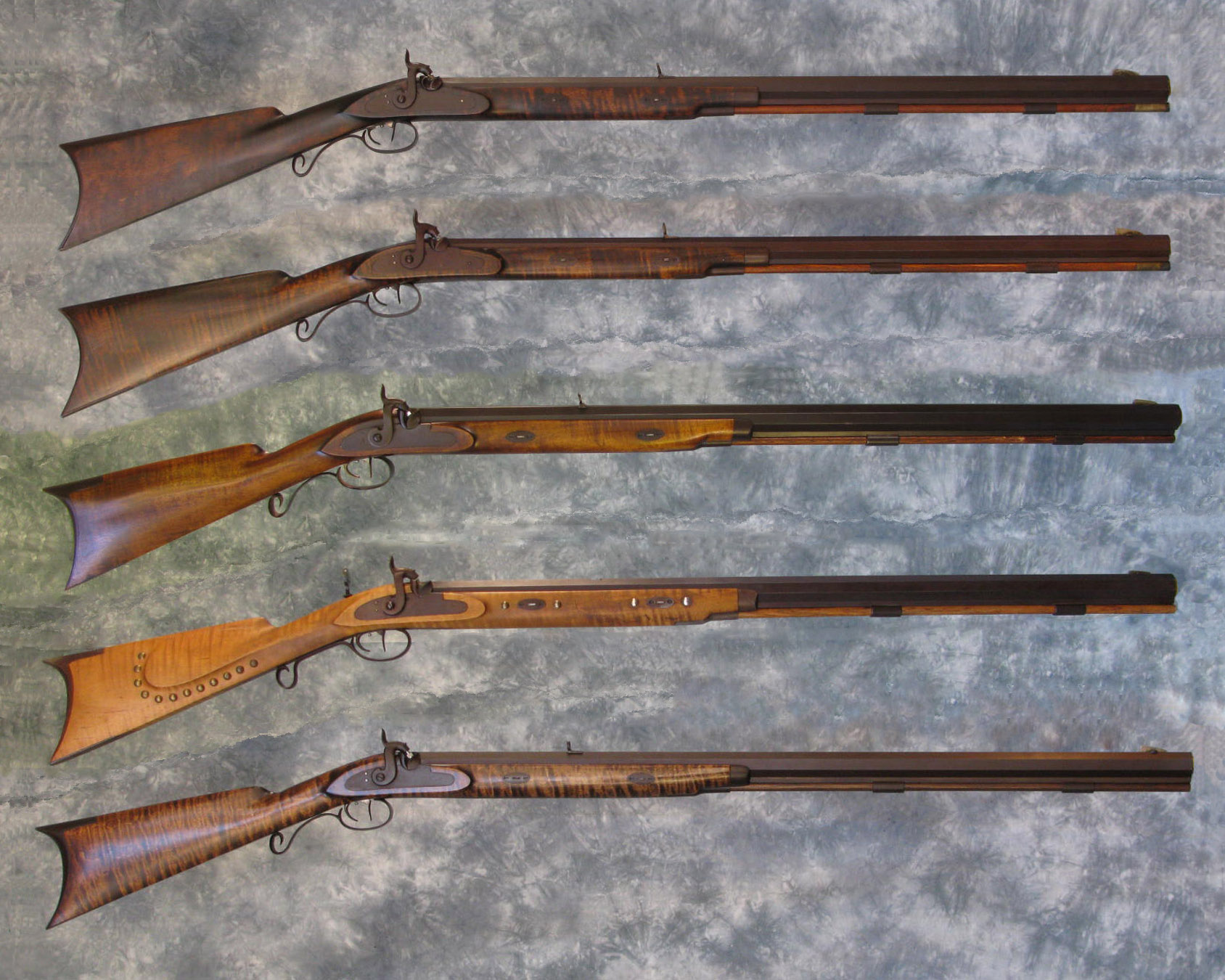Under Construction
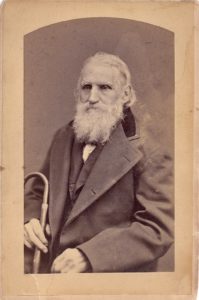
Even though the Leman Trade Rifle was the first production rifle and the biggest seller, the rifle most identified with Green River Rifle Works is the Hawken rifle.
While Doc White was stationed in Alaska during his tour with the Army in the late 1960’s, he had the good fortune to handle, shoot, and even disassemble several original Hawken rifles in private collections. He took photographs, made notes, and formulated ideas and plans to build Hawken rifles. These plans finally came to fruition with the formation of Green River Rifle Works early in 1972.
Doc has this picture of an original Hawken rifle on his website. He had also written an article about it that was published in the July 1975 issue of Buckskin Report titled, “An Unusual Hawken”.
The article describes the rifle in detail, giving several measurements including, “The barrel is 36-3/4 inches long and measures 1-5/32 inches at the breech and 1-3/16 inches at the muzzle.” He also states, “The fore-end tip is constructed of thin sheet iron, brazed together. It measured 7/8 inches in length and is attached with a single screw (head goes inside next to barrel).” As Doc’s caption to the picture says, this is his favorite Hawken rifle. I’ll come back to discussing some aspects of it later.


The very first ad that the Rifle Works placed in Muzzle Blasts magazine announcing the introduction of the Leman Trade Rifle included a statement, “Coming soon: A faithful copy of the S. Hawken Rifle. Dealer inquiries invited: send for whole-sale parts list.”
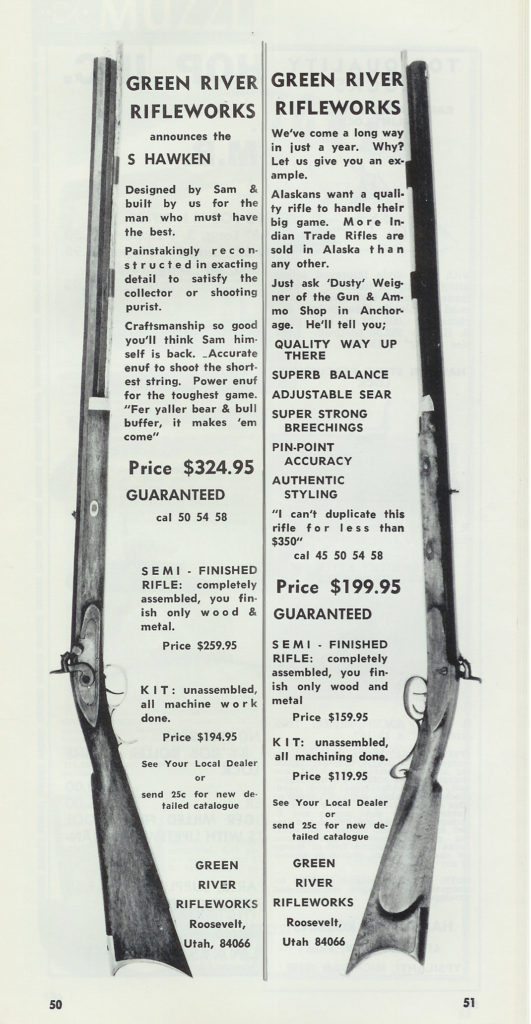
It took another year before Doc and Carl Walker were ready to put the Hawken rifle into production. The first ad for the new S. Hawken rifle appeared in the May 1973 issue of Muzzle Blasts.
The ads for the S. Hawken rifle and the Leman Trade Rifle appeared on opposing pages. There was an error in the ads–the photographs for the rifles were switched.
The Hawken rifle proved to be a more difficult rifle to build than the Leman rifle. Where the Leman had a flint style breech plug with a short tang, the Hawken utilized a hooked breech with a long tang and two tang bolts fastened to the trigger plate.
Fitting the hooked breech and inletting the long tang is more complicated and takes longer. The Hawken also used a long bar, double set trigger as standard component while the Leman had a simple single trigger pinned to the stock and a short trigger plate that the tang screw fastened to. Again, more time and effort was required to inlet the Hawken triggers.
The Hawken also borrowed the English method of fastening the trigger guard to the long bar trigger plate where the guard on the Leman is pinned to the stock.
Then there is the issue of the stock architecture. The Leman rifle is basically a late Lancaster style rifle. The Hawken is a different style that may be a blend of a number of different influences from English sporting rifles to Harper’s Ferry Model 1803 to Southern Mountain rifles. Getting the Hawken stock architecture right proved to be a little more elusive.
Sourcing the components for the Hawken rifle was also problematic. Hawken butt plates and trigger guards were plentiful enough from a number of suppliers, but a suitable Hawken lock and double set triggers were more limited.
Bob Roller was producing a Hawken lock and triggers on a limited scale. Bud Brown of Cherry Corners had introduced his Hawken lock in 1970 and was also selling long bar Hawken triggers. Ron Long wouldn’t start producing his Hawken lock and triggers for another two years.
That first year of Hawken production occurred as the company moved from Doc’s garage to an 8000 sq. ft. warehouse and started adding additional equipment and staff. There would eventually be a full machine shop with lathes and mills and stock duplicating equipment.
These changes and challenges meant that Carl Walker and the other employees hired that year would be on a steep learning curve trying to improve and standardize the GRRW Hawken rifle and produce it on a commercial scale. Studying the GRRW Hawken rifles produced from 1973 to 1980 show that Carl, Gardell Powell, Ed Trump, Neill Fields, Ron Paull, Bill McKay, Don McKee, Lloyd Helms, and others steadily improved their skills and knowledge over the period.
Innovations and improvements in the machine shop in the form of jigs and fixtures to speed up processes and reduce labor were also occurring. These included jigs to cut barrel channels, other jigs to drill ramrod holes in a half stock, templates to rough out the lock mortise with a mill or router, etc.
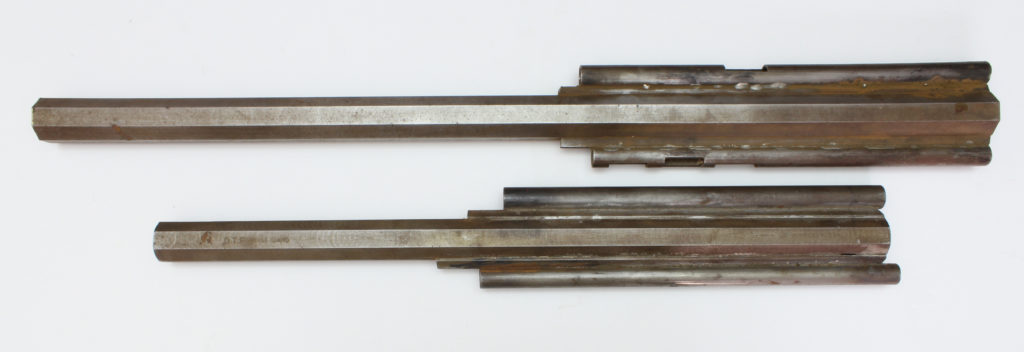
The Rifle Works eventually standardized on a set of components and a stock pattern for the Hawken rifle, but over time, suppliers changed ownership or quit the business, new and better components came to market, and the components they used changed. As a result, the look and feel of the GRRW Hawken rifle changed over time.
After collecting and studying a number of GRRW Hawken rifles in mine and others collections, it was apparent that the improvement in skills and knowledge of the employees and the changes in components lead to an evolution of the GRRW S. Hawken rifle. As a result of this evolution, the Hawken rifles could be classified into five groups or patterns. A sixth group was added as a catchall, dealing with variants or custom orders. I’ve chose to call these patterns the following:
- The Experimental Pattern
- The First Standard Pattern
- The Transition Pattern
- The MHS Bridger Commemorative Pattern
- The “Bridger” Pattern
- The Custom Hawken
The Experimental Pattern
I decided to call the first group the “Experimental” pattern. Either intentionally or unintentionally, the folks at the Rifle Works used different component parts during this period. They also changed some of the details of the stock shape. It’s almost as if they were experimenting with different parts and stocks before deciding on a fixed pattern. The Experimental Pattern includes one or more prototype rifles and rifles SN’s H-001 to at least H-031.
Doc had built the prototype for the S. Hawken rifle. Pictures of it were used in the early advertisements.

Another Hawken purported to be a GRRW prototype sold a number of years ago on the internet. It has the same lines and a number of characteristics as the rifle pictured above.
The lock on this rifle, particularly the hammer, looks like one of Ron Long’s Hawken locks. These weren’t available when Doc or Carl would have still been building prototypes for the S. Hawken rifle. If this is an early prototype for the GRRW Hawken rifle, then the lock was changed out at a later date.
Otherwise, this rifle fits the GRRW Experimental Pattern.
This is Hawken SN H-004 which was built in ?March? 1973.
The lock on Doc’s prototype and on H-004 appear to be different from each other but aren’t identifiable. The barrels on the two prototypes above aren’t known, but H-004 was built with a Bauska barrel. The butt plates on the three rifles shown above are all different. The snail on the breech bolsters of the three rifles also appear to be different.
Hawken H-020 also fits into this group.
Again, the lock and snail are different on H-020 than the previous rifles. The wide lock panels are consistent on these rifles, though.
H-004 does not have any company stamps on its barrel–just the serial number. H-020 has serial number, .58 for caliber, a letter B, probably for Bauska barrels, BLACK POWDER ONLY in front of the rear sight, GREEN RIVER RIFLE WORKS about midway between breech and rear sight, and WOHFAHRT on the bottom flat near the breech. There is no address stamp on the barrel.
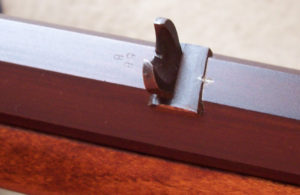
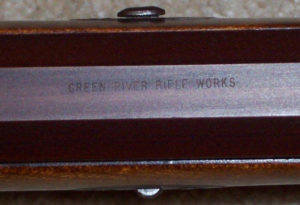
 This latter stamp appears to be after-market. The most likely explanation is that H-020 was sold as a semi-finished rifle and the customer added the WOHFAHRT stamp when he was finishing the rifle.
This latter stamp appears to be after-market. The most likely explanation is that H-020 was sold as a semi-finished rifle and the customer added the WOHFAHRT stamp when he was finishing the rifle.
The next rifles in this group that we’ve seen pictures of are SN’s H-029, H-030, and H-031. These rifles have a number of features in common, but differ from the earlier rifles in the group. The most noticeable feature on these three rifles is that they all have Cherry Corners locks.
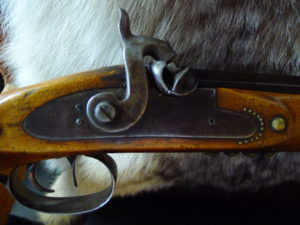
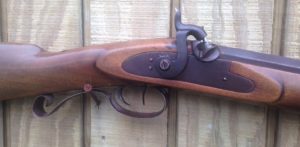
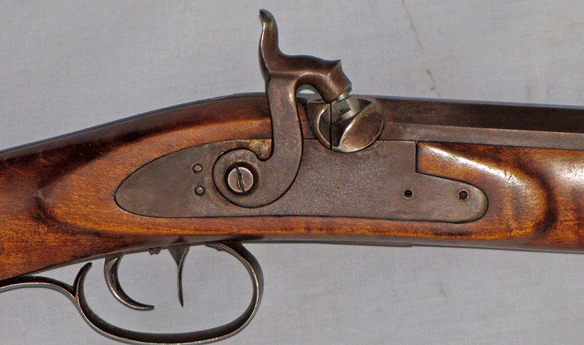
They also have Cherry Corners breech plug & tang, and Cherry Corners triggers. The butt plate and trigger guards could be from Cherry Corners, too.
H-029 has been highly personalized by its owner with the addition of an oval patch box and brass tacks. It’s also seen heavy use hunting for big game in Montana including elk, deer, bear, and Rocky Mountain goat.
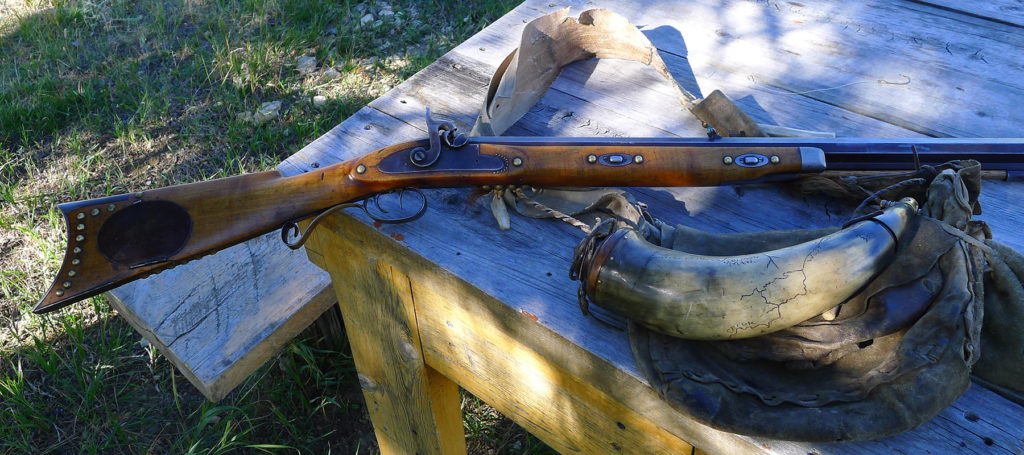
H-030 has also been modified since leaving the factory. In this case, the cheekpiece was changed to be similar to an original shown in Baird’s first book. This type of modification suggests that H-030 was a semi-finished rifle and the customer modified the cheekpiece before staining and finishing the stock.


H-031 is the highest serial number currently known in the “Experimental” pattern. With so many Cherry Corners parts being incorporated in these rifles, they might be near Cherry Corner’s kits assembled by the GRRW smiths, especially if one or more of the stocks had been acquired from Cherry Corners.


From the photos, the stock shape appears to have been refined further with these last three rifles. The prototypes and H-004 and H-020 have thicker wrists, the shape of the comb is a little different, and the lock panels are wider. It’s likely that by the time H-029, H-030, and H-031 were built, GRRW had acquired their stock duplicator and began to standardize their Hawken stock. We may also be seeing the influences of some of the new employees that had more exposure and knowledge of original rifles such as Bluejacket. It may very well have been a collaborative effort of several employees, but it’s obvious that there was a strong desire to improve the authenticity and the quality of the GRRW Hawken.
With all the variations in the rifles from this pattern, the one consistent feature seen on all of them is the poured pewter nose cap. These are the only factory finished Hawken rifles seen with pewter nose caps. Subsequent rifles utilize either two-piece sheet metal or cast steel nose caps. The main features that separate the last of this pattern from the next pattern are the locks used and the nose cap.
All the Experimental Pattern rifles were made in 1973.
The First Standard Pattern
To be able to speed up production and reduce costs, it was obvious that GRRW needed to standardize the components used on their rifles. This would enable more jigs and fixtures to be used to save labor and time. The period of experimentation had come to an end.
An in-house stock duplicator ensured the stocks would be shaped to a set pattern. The William Morgan lock would be used exclusively as would Cherry Corners breech & tang. Either Cherry Corners or Ron Long’s triggers were used. The trigger guards and butt plates were fairly generic and pretty much the same from several suppliers. As long as they were available, Douglas barrels would be used. These proved to be the weakest link in the supply chain, and it became obvious to GRRW management that they would need to start making their own barrels soon.
The rest of the small parts would be made in the GRRW shop. This included barrel staples, barrel wedges, wedge escutcheons, entry pipe and forward pipes, ribs, front and rear sights, toe plates, and the two-piece sheet metal nose cap.
The nose cap on the First Standard Pattern Hawken would be a copy of the one on Doc’s favorite original Hawken. A number of original J&S Hawken and S Hawken rifles have this type of nose cap. A thin sheet of metal was cut to size and then bent to form a ramrod groove and shaped around a mandrel that conformed to the shape of the forearm. A second piece of sheet iron was cut to fit the front of the curved piece and brazed or soldered to it.
The nose cap was fastened to the stock with a small screw passing through from the barrel side just as Doc described in his article.
Procuring locks was almost as difficult as getting barrels. None of the Hawken lock makers of the day–Cherry Corners, Bob Rolller, A. Schillinger–were willing to contract to provide locks in the quantity that GRRW needed. Similar to the approach for barrels, the Rifle Works decided to order the cast lock parts in quantity and assemble them in-house.
Roller and Schillinger were machining their lock parts, so they weren’t a likely source. William Morgan had developed castings based on the lock on the Orville Dunham Hawken that was shown in Baird’s first book. The Frontiersman in Royal Oak, Michigan was marketing kits for the Morgan lock. They may have been the supplier for GRRW.
The Rifle Work’s 1976 Catalog/Brochure has a group picture of most of the GRRW employees of the period. Rick Guthrie, Jimmy Summarell, and Dave Holmes are listed as locksmiths. The Rifle Works also purchased lock castings from Bud Siler and assembled Siler locks for their rifles. When Ron Long started making his Hawken triggers and locks, GRRW would buy castings from him and assemble the triggers and locks in their shop.
The First Standard Pattern Hawken is near and dear to my heart. It was the pattern most used to illustrate the 1974 paperback book, Guns & Ammo – Complete Guide to Blackpowder, which introduced me to Green River Rifle Works and their Hawken rifle. A close-up of the rifle with the William Morgan lock is illustrated on page 24 and a full length view of a First Standard Pattern rifle is shown on page 25 along with a Thompson Center Hawken and a Hawken Hurricane from Navy Arms. There was no question which modern Hawken looked most like the original, and I was hooked on GRRW and their First Standard Pattern Hawken.
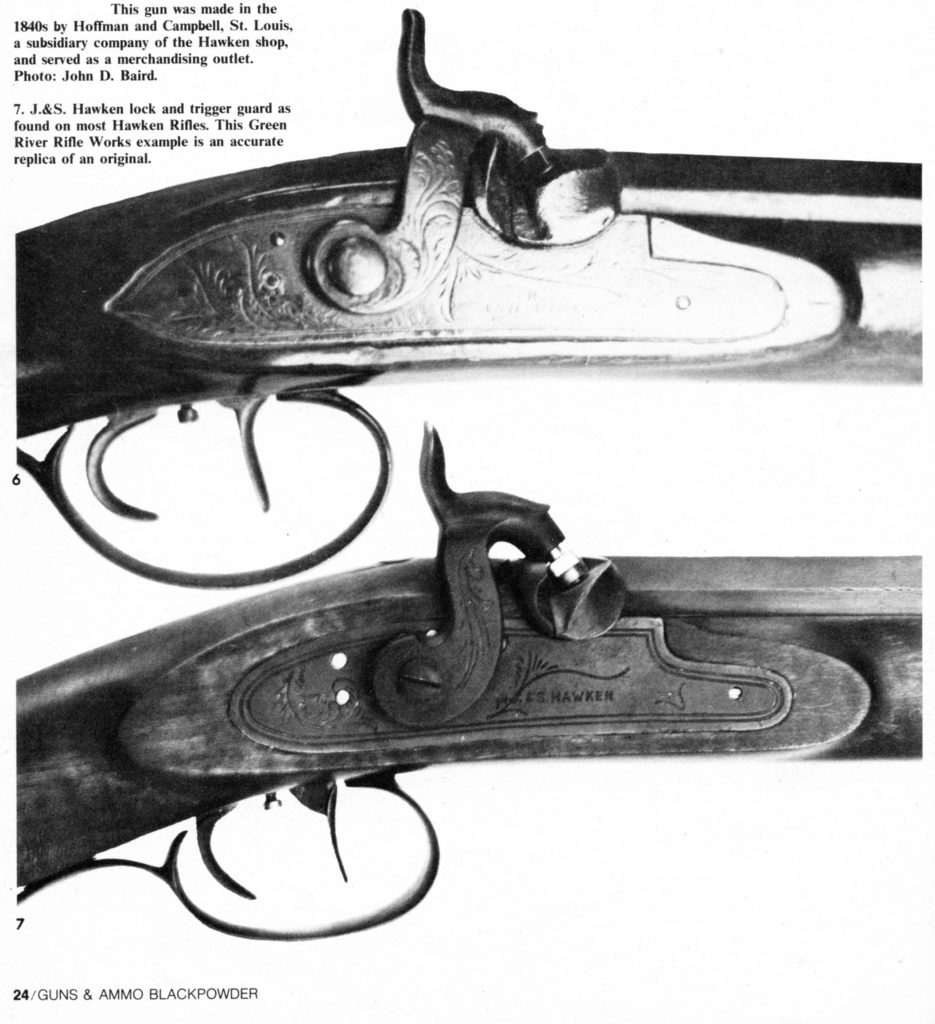

GRRW Hawken H-036
The earliest example of this pattern that I know of is H-036.
It was built with Cherry Corners breech & tang which was standard for this pattern. It also has Cherry Corners triggers. Later rifles in this pattern may have Ron Long triggers. The William Morgan lock is obvious.
GRRW Hawken H-067
The GRRW record book for the first couple of years is incomplete. Only the serial numbers were recorded–no details about the rifles such dates, which builder it was assigned to, or the customer and address. We don’t know for sure who made this rifle. Most likely it was Carl Walker. Carl says he probably built more Hawken rifles than anybody else. Gardell Powell probably contributed the second most.
It was probably built in late 1973.
The barrel is stamped with the serial number and caliber on the left oblique flat near the breech and with “GREEN RIVER RIFLE WORKS” over “ROOSEVELT, UTAH” in front of the rear sight.
At first blush, H-067 appears just like the other rifles in this pattern. The lock is a William Morgan. The breech & tang are from Cherry corners. The barrel is a Douglas barrel in .50 caliber, 1 inch across the flats, and 32″ long.
On closer inspection, little differences are apparent. The ramrod is 3/8″ OD instead of the typical 7/16″ OD. The underrib is also thinner than most. The typical underrib on a modern Hawken rifle would measure 0.25″ from the flat that contacts the barrel to the base of the groove for the ramrod. On H-067, that distance is less than 0.20″. In other words, the web in the forearm between the barrel channel and the ramrod hole is less than 0.20″ instead of the more common 0.25″ web. The thinner web and smaller ramrod makes the forearm on H-067 much slimmer than other Hawken rifles. The slim lines are carried through the lock area and into the wrist. That seven hundredths of an inch (five for the web and two for the ramrod) makes the rifle feel and look slimmer–more than you would think.
.
GRRW Hawken H-112
This next rifle, serial number H-112, is the second factory GRRW rifle I acquired. I purchased it from the original owner who lived in Pueblo, Colorado in November of 2008. The rifle was made by Ed Trump in April 1974. It has a 1″ x 32″ straight octagon barrel. The caliber is .54 and there are 8 lands and grooves, indicating that it has a Douglas barrel. The top flat of the barrel is marked in front of the rear sight with “GREEN RIVER RIFLE WORKS” over “ROOSEVELT, UTAH” and the caliber and serial number are stamped on the left oblique flat near the breech.
H-112 has the standard 1/4″ thick underrib and fitted with a 7/16″ diameter ramrod, thus making it thicker in the forearm than H-067.
These early Hawken rifles have dovetailed under lugs for the barrel keys to pass through and hold the barrel in the stock. Later GRRW Hawken rifles used barrel staples as described in the section on “Barrel Loops”.
The barrel keys themselves are also different than what was used on later rifles. They are thicker and narrower, being only a 1/4″ wide and 1/8″ thick. They also have rectangular heads rather than oval heads. These were made in the GRRW shop along with the other small parts used on the rifle. John Baird’s Hawken Rifles – The Mountain Man’s Choice describes an early J&S Hawken rifle with retaining key that have rectangular heads, and it’s possible that was the inspiration for the shape of the keys used on these First Standard Pattern rifles.
The barrel on H-112 has some additional stamps on the bottom flat near the breech. As seen in the picture below, the stamp is “B .54“. The “.54” undoubtedly refers to the caliber, but the significance of the “B” is not known at this time.
The stocks have a feature that was common on pre-shaped stocks of the 1970″s. A groove was cut in the bottom of the barrel channel with a router for a portion of its length to facilitate the drilling of the ramrod hole. The groove is the same depth and the ramrod hole and served as a guide while drilling the ramrod hole in the stock to ensure that the hole did not wonder to one side or the other or up or down, thus ruining the stock. We also see a very small amount of glass bedding was used under the standing breech and hooked breech to ensure a good fit in the stock. Both of these features are absent in later GRRW Hawken rifles.



